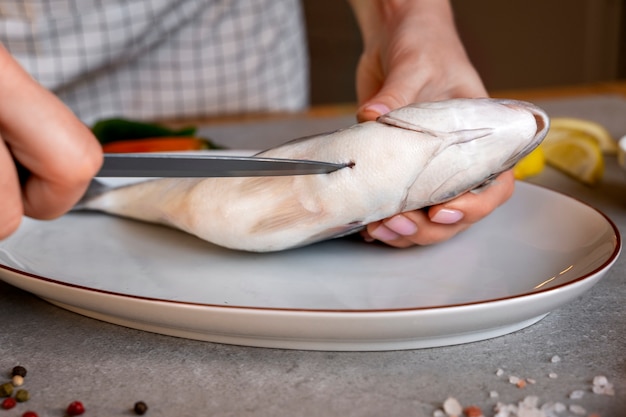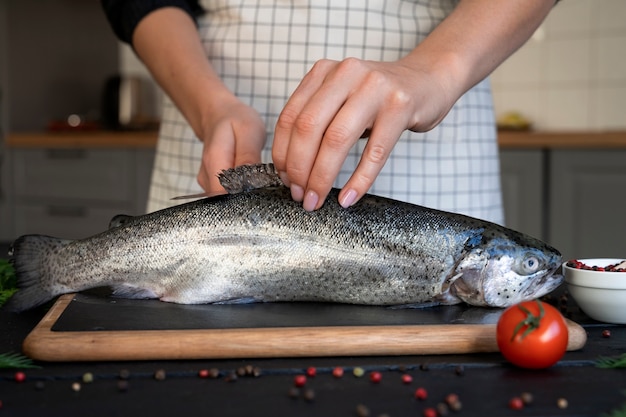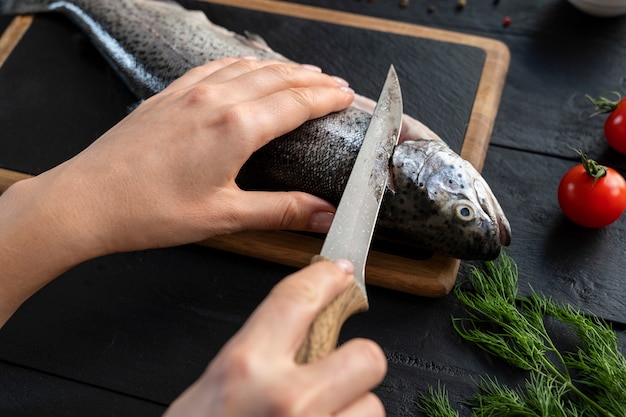Frozen swordfish? Yes, you read that right! It might seem like an odd choice, but trust me, frozen swordfish can be just as delicious as fresh, especially when you know a few tricks. I've been a bit of a fish fanatic for years, thanks to my mum's amazing cooking. Frozen fish became a lifesaver for me, especially those times when I needed a quick and easy meal. Let's face it, frozen fish is readily available and doesn't require a lot of fuss, making it a real winner in my book.
Ready to learn how to cook frozen swordfish like a pro? Let's dive in! We'll cover everything from picking the right fish to cooking methods and serving suggestions, ensuring you end up with a delicious, perfectly cooked meal every time.
Part 1: Choosing the Right Frozen Swordfish

Picking Your Perfect Frozen Swordfish
The journey to a delicious frozen swordfish dish starts with choosing the right one. It's like selecting the perfect ingredients for any recipe - you want to ensure you're starting with quality. Here's what to look for when picking out your frozen swordfish at the supermarket:
- Quality: First and foremost, look for a swordfish that's firm to the touch, not mushy or soft. The colour should be a consistent silvery-grey with no discolouration. Keep your eye out for any signs of freezer burn – that white, dry stuff that can sometimes appear. It's best to avoid these as it indicates the fish has been exposed to temperature fluctuations and may not be as fresh.
- Thickness: I've found that swordfish steaks about 1-1.5 inches thick are ideal for most cooking methods. This thickness allows for even cooking, preventing the fish from becoming dry or overcooked.
- Packaging: Opt for vacuum-sealed or individually-wrapped frozen swordfish. This type of packaging helps prevent freezer burn, which can compromise the flavour and texture of the fish. It also ensures that the fish remains fresh and protected until you're ready to use it.
While you're at the supermarket, don't forget to check the use-by date. You want to make sure you're purchasing frozen swordfish that's still within its peak freshness. Also, ensure that the packaging is intact and free from any tears or punctures, which could indicate potential damage to the fish.
Don't let the fact that you're buying frozen swordfish deter you from expecting high quality. With a little knowledge and a bit of attention to detail, you can find frozen swordfish that will rival fresh in terms of flavour and texture.
Part 2: Thawing Frozen Swordfish

Thawing Time: The Right Way
Thawing frozen swordfish is a crucial step in the cooking process, as it directly affects the texture and flavour of the finished dish. It's important to thaw your frozen swordfish slowly and safely to avoid those dreaded mushy bits that can happen with rushed thawing.
Here are the best ways to thaw your frozen swordfish:
- Refrigerator: This is my go-to method for thawing frozen swordfish. It's the most gentle and ensures even thawing. Simply transfer your frozen swordfish from the freezer to the refrigerator and let it thaw slowly overnight. This takes about 8-12 hours, but it's worth it for the quality and texture it delivers.
- Cold Water: If you need to thaw your frozen swordfish more quickly, you can do it in a bowl of cold water. Place the sealed package in a bowl filled with cold water, ensuring the water level is high enough to cover the package completely. Change the water every 30 minutes to keep it cold. This method takes about 30-60 minutes, depending on the size of the swordfish.
- Never: Never thaw frozen swordfish at room temperature. This can lead to the growth of harmful bacteria, which can make you ill. Always thaw frozen fish in the refrigerator or in cold water.
The Importance of Patience
I know it can be tempting to speed up the thawing process, especially when hunger pangs start to kick in. But trust me, taking the time to thaw your frozen swordfish properly is key to a delicious result. It ensures that the fish cooks evenly and develops a tender, moist texture. The patience you invest in thawing will be rewarded with a superior culinary experience.
Part 3: Preparing Frozen Swordfish for Cooking

Patting It Dry: The Key to crispy skin
Once your frozen swordfish has thawed, it's time to get it ready for cooking. This next step is essential for achieving that beautifully crispy skin, which adds a fantastic texture to your swordfish.
- Pat it Dry: Thoroughly pat the swordfish dry with paper towels. This removes any excess moisture, which can prevent the skin from becoming crispy and lead to a soggy texture.
- Seasoning: Now, it's time to season your swordfish to your heart's content. While a simple salt and pepper combination works wonders, feel free to get creative with your favourite herbs and spices. My personal favourite is a pinch of paprika and a squeeze of lemon juice, which adds a delightful tanginess.
The Perfect Skin: A Secret Weapon
Here's a little secret for achieving a gloriously crispy skin: Heat some oil in a pan over medium-high heat. Then, gently place the swordfish, skin-side down, into the hot oil. This searing technique helps create a beautiful, crispy skin, giving your swordfish a delightful textural contrast.
Part 4: Cooking Frozen Swordfish: The Methods
The Great Grill Debate: Charcoal vs. Gas
I'm a huge fan of grilling swordfish. The smoky flavour it develops from grilling is truly fantastic, and it gives the fish a wonderful char. However, there's a bit of a debate amongst grilling enthusiasts: charcoal vs. gas.
Now, I personally prefer the taste of charcoal-grilled swordfish. There's a unique, deep smoky flavour that can't be replicated with a gas grill. However, gas grills are more convenient and provide more control over the temperature. Ultimately, the choice comes down to your personal preference.
Grilling Time: Get That Perfect Char
Whether you prefer gas or charcoal, here's how to grill your swordfish to perfection:
- Prep: Preheat your grill to medium-high heat. If you're using a charcoal grill, make sure the coals are glowing red and have a good bed of ash.
- Oil: Lightly oil the grill grates with a little olive oil. This will prevent the swordfish from sticking, ensuring a clean release when it's cooked.
- Grill: Place the swordfish on the grill, skin-side down, and cook for 4-5 minutes, or until it develops a nice char. Then flip it over and cook for another 2-3 minutes, or until it's cooked through.
- Rest: Remove the swordfish from the grill and let it rest for a few minutes before serving. This allows the juices to redistribute, resulting in a more tender and juicy fish.
Beyond the Grill: Other Cooking Methods
While grilling is my favourite way to cook swordfish, there are plenty of other excellent methods to choose from, each offering a unique flavour and texture profile.
- Pan-Seared: Heat a little oil in a pan over medium-high heat. Sear the swordfish for 3-4 minutes per side, or until it's cooked through. This method delivers a beautiful crust and a tender interior.
- Baked: Preheat your oven to 375 degrees Fahrenheit (190 degrees Celsius). Place the swordfish on a baking sheet lined with parchment paper and bake for 10-12 minutes, or until it's cooked through. Baking is a great way to cook swordfish evenly and achieve a moist texture.
- Broiled: Preheat your broiler. Place the swordfish on a baking sheet lined with parchment paper and broil for 4-5 minutes per side, or until it's cooked through. Watch it closely to prevent it from burning. Broiling gives the swordfish a nice char and a slightly smoky flavour.
Part 5: cooking time: Knowing When It's Done
The "Poke Test": A Simple Guide
How do you know when your frozen swordfish is cooked to perfection? The most straightforward method is the "poke test". Gently insert a fork into the thickest part of the fish. If the flesh flakes easily and is opaque, not translucent, it's cooked through.
The internal temperature: A Precise Method
For those who prefer a more precise method, use a meat thermometer to check the internal temperature of your swordfish. The USDA recommends an internal temperature of 145 degrees Fahrenheit (63 degrees Celsius) for swordfish.
Overcooked Swordfish: A Common Mistake
A common mistake when cooking swordfish is overcooking it. Swordfish is a lean fish, so it can dry out quickly if cooked for too long. It's crucial to avoid overcooking, as this will result in a tough and dry texture.
Part 6: Serving Your Delicious Swordfish
The Perfect Accompaniments: A Culinary Symphony
Now that your frozen swordfish is cooked to perfection, it's time to choose the perfect accompaniments to create a delicious and well-balanced meal.
Here are a few of my favourite pairings:
- Roasted Vegetables: Roasted vegetables, like asparagus, broccoli, or Brussels sprouts, are a classic pairing for swordfish. They bring a delightful sweetness and depth of flavour that complements the fish perfectly.
- Citrus Salad: A light and refreshing citrus salad, with oranges, grapefruit, and lemons, is a fantastic way to cut through the richness of the swordfish. The acidity of the citrus brightens up the dish and adds a refreshing element.
- Green Salad: A simple green salad with a light vinaigrette is always a winner. It provides a clean and crisp contrast to the rich, meaty swordfish, adding a refreshing element to the meal.
- Garlic Butter: A dollop of garlic butter adds a burst of flavour to the fish, enhancing the taste without overwhelming it. It's so simple, yet so effective.
- Lemon Herb Sauce: A vibrant and aromatic lemon herb sauce, made with fresh herbs like parsley, dill, and chives, complements the swordfish beautifully. It adds a fresh and zesty flavour that balances the richness of the fish.
Part 7: Storing Leftover Swordfish
Keeping It Fresh: Proper Storage
If you have leftover swordfish, store it in the refrigerator in an airtight container for up to 3 days.
Don't Freeze It Again: A Crucial Tip
It's important to note that you shouldn't freeze leftover cooked swordfish. The freezing process can alter the texture and flavour, making it less appealing. Stick to refrigerating it for the best quality.
Part 8: FAQs: Your Swordfish Questions Answered
FAQs: Everything You Need to Know
Let's address some common questions about frozen swordfish to clear up any doubts or misconceptions.
- Is frozen swordfish safe to eat? Yes, absolutely! Frozen swordfish is just as safe to eat as fresh swordfish. The freezing process doesn't affect the safety or quality of the fish.
- How long can I store frozen swordfish? Frozen swordfish can be stored in the freezer for up to 3-6 months.
- Can I eat frozen swordfish raw? It's not recommended to eat frozen swordfish raw. Like any fish, it should be cooked thoroughly to kill any bacteria.
- Can I grill frozen swordfish without thawing it? It's not recommended to grill frozen swordfish. It won't cook evenly and the skin will likely stick to the grill grates. It's best to thaw the fish properly before grilling.
- What does swordfish taste like? Swordfish has a slightly sweet and nutty flavour, and a firm, meaty texture. It's a versatile fish that can be cooked in various ways and pairs well with a variety of flavours.
I hope this article has been helpful and given you the confidence to cook delicious frozen swordfish. Remember, with the right techniques and a little patience, you can create a fantastic meal using frozen swordfish. If you have any more questions, feel free to leave a comment below. Happy cooking!
Everyone is watching

Corn on the Cob: The Ultimate Guide to Perfectly Cooked Ears
Healthy MealsAh, corn on the cob. Just the name evokes images of sunny days, barbecues, and that sweet, juicy flavour that ...

Perfect Pork Roast Oven Cooking Time: A Guide to Delicious Results
Healthy MealsThere's something truly satisfying about a perfectly roasted pork. The aroma alone is enough to make your mout...

Ham Cooking Time: How Long to Bake, Smoke, or Boil a Delicious Ham
Healthy MealsAh, ham. It's a classic, isn't it? A real crowd-pleaser, especially around holidays. And when done right, it'...

Scallops: The Ultimate Guide to Perfect Cooking
Healthy MealsAh, scallops. Those delicate, sweet, and utterly delicious morsels of the sea. They hold a special place in my...

Spaghetti Squash: The Ultimate Guide to Cooking and Serving
Healthy MealsRemember that time you saw spaghetti squash at the supermarket, looking all bumpy and strange, and thought, "W...
